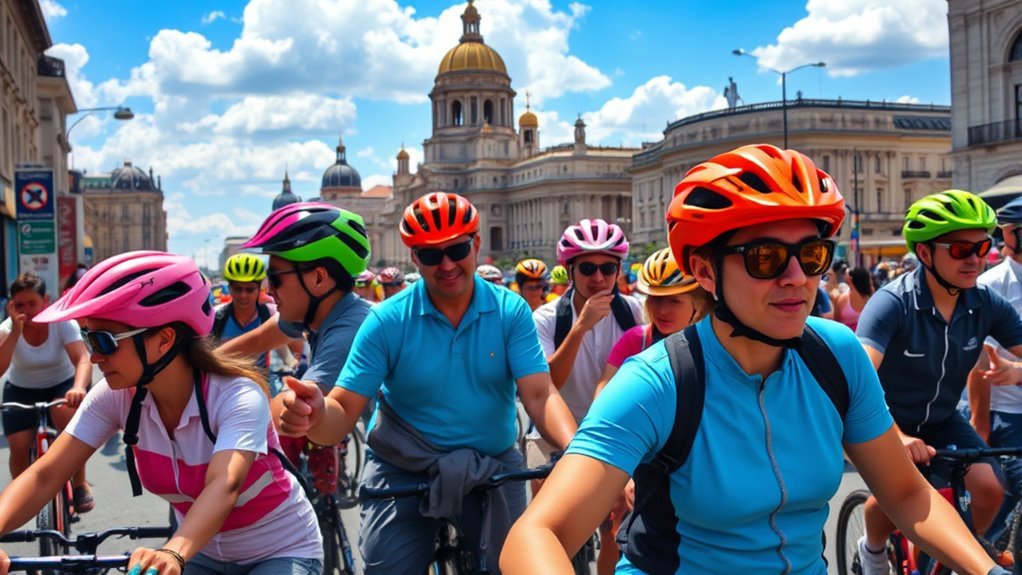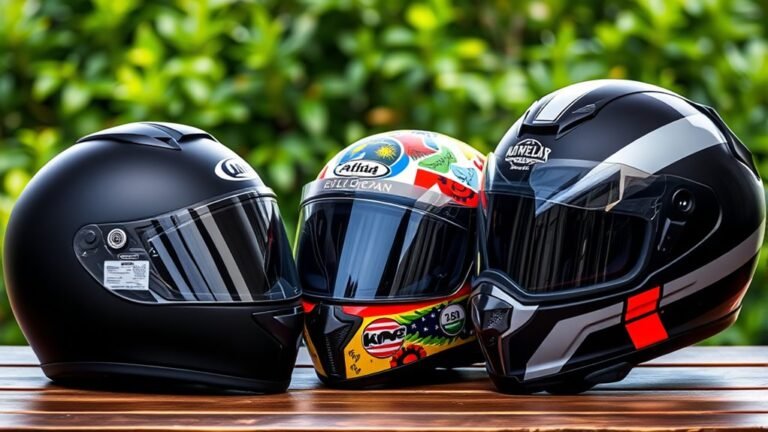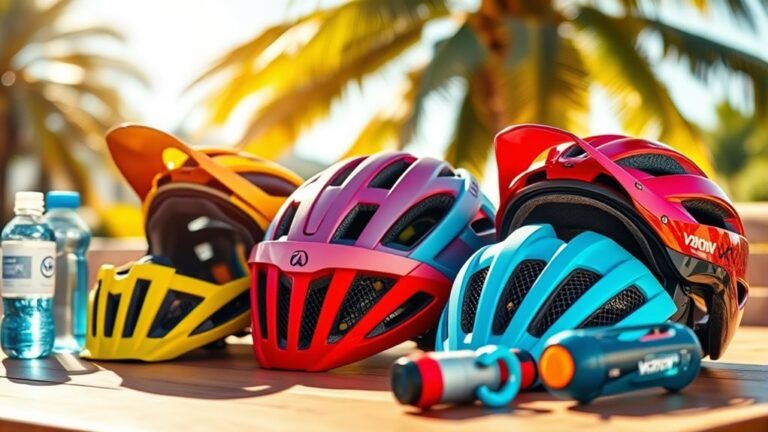How to Stay Compliant With Helmet Regulations Abroad
To stay compliant with helmet regulations abroad, start by researching the specific laws for your destination before you travel. Check official government websites and trusted travel resources for the latest information. Different countries may require specific helmet types that meet local safety standards. If renting a vehicle, confirm the rental agency’s helmet policies. Knowing these details will help you avoid fines and guarantee a safer riding experience. There’s much more to explore about helmet safety and compliance.
Understanding Local Helmet Laws
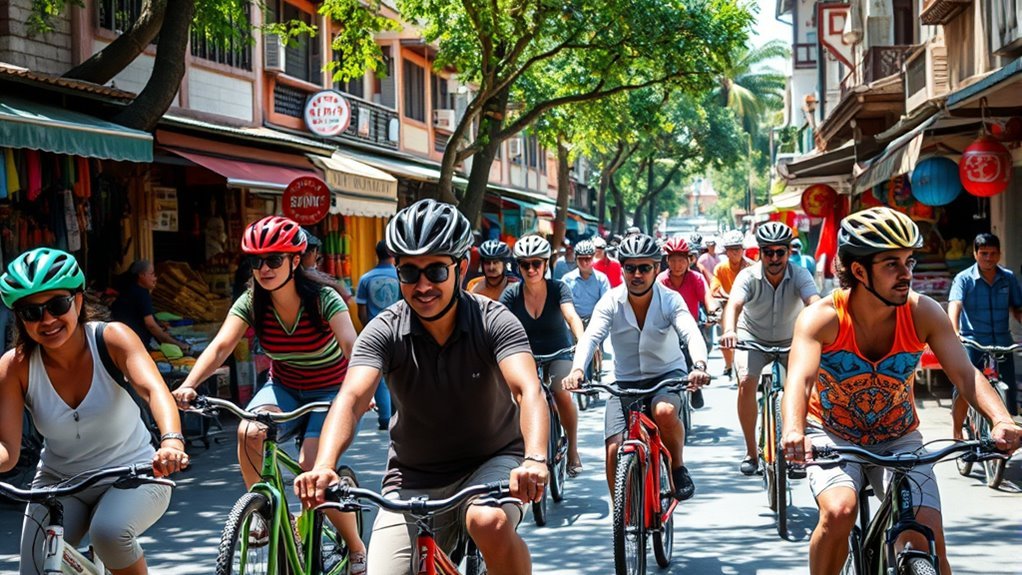
How well do you know the helmet laws in your area? Understanding these regulations is vital for your safety and freedom, especially when you’re out there riding. Local laws can vary greatly, so it’s essential to familiarize yourself with what’s required. In many places, wearing a helmet is mandatory, while others may only require it for younger riders. Always prioritize helmet safety, as a good helmet can protect you from serious injuries. If you plan on international travel, do your homework on the helmet laws of your destination. Some countries have strict regulations, and you don’t want to face penalties or unsafe conditions. Stay informed, stay safe, and enjoy the ride while respecting the rules of the road.
Researching Regulations Before Your Trip

Before you set off on your trip, have you taken the time to research the helmet regulations of your destination? Understanding local laws is vital for ensuring your helmet safety while enjoying your adventure. Start by checking official government websites or trusted travel resources for the latest regulations. Look into whether specific types of helmets are required, as different countries have varying standards. This research is an essential part of your travel planning, allowing you to avoid fines or complications during your journey. Remember, being informed not only keeps you compliant but also enhances your freedom on the road. Equip yourself with the right knowledge, and you’ll be ready to explore without worry!
Types of Helmets Required in Different Countries
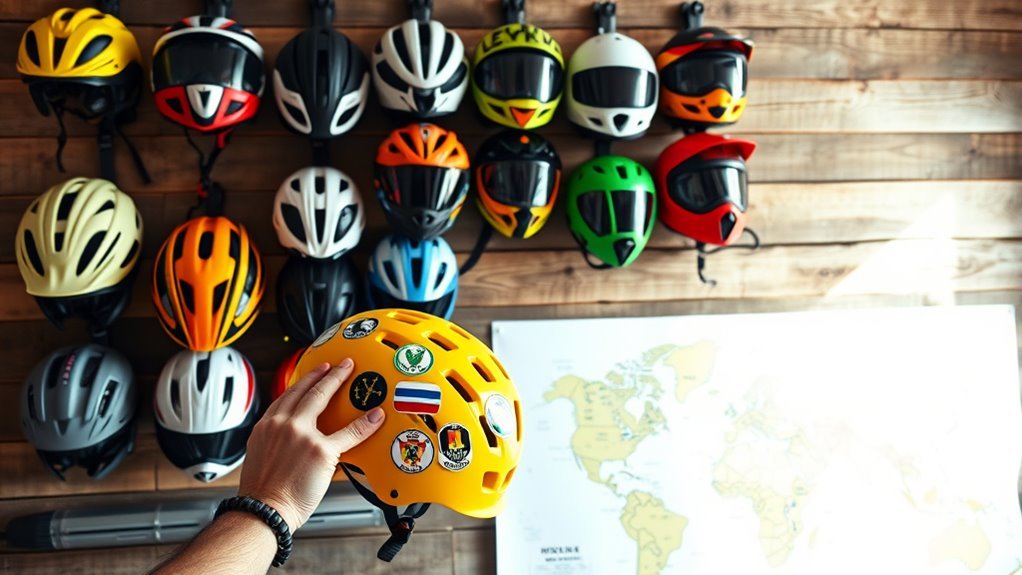
When traveling, it’s essential to understand the helmet requirements specific to each country you’ll visit. Different nations have standard helmet regulations, and some may even have specialty helmets for particular activities or cultural practices. By familiarizing yourself with these rules, you’ll guarantee compliance and safety while enjoying your ride.
Standard Helmet Requirements
While each country has its own set of regulations regarding helmet use, understanding the standard requirements is fundamental for ensuring your safety and compliance. Most countries require helmets that meet specific helmet safety standards, which can vary considerably. For instance, in the EU, helmets must adhere to ECE R22.05 standards, while in the U.S., DOT certification is essential. Some countries, like Australia, have their own AS/NZS 2063 standards. It’s important to check the local regulations before riding, as many places enforce international helmet policies that may not align with your home country’s rules. Always prioritize a helmet that fits properly, offers adequate protection, and meets the required standards to enjoy your freedom on the road safely.
Specialty Helmet Regulations
Understanding standard helmet requirements is just the beginning; it’s equally important to know that different types of helmets are mandated based on specific activities and regions. For instance, if you’re mountain biking in New Zealand, you’ll need a helmet that meets their strict international standards for off-road riding. Conversely, in some European countries, a full-face helmet might be required for motocross. Specialty helmet types such as ski helmets or equestrian helmets also come with their own regulations, ensuring safety tailored to each sport. Always check local laws before you ride; compliance not only protects you but also enhances your freedom to enjoy your adventure. Stay informed and choose the correct helmet type to match your activities abroad.
Cultural Helmet Practices
How do helmet regulations vary around the globe? You’ll find that cultural variations greatly influence the types of helmets required in different countries. In some nations, like the Netherlands, lightweight cycling helmets symbolize safety and practicality, while in others, such as India, brightly decorated helmets might reflect local customs or fashion rather than strict safety compliance. In Australia, motorcycle riders must wear full-face helmets, emphasizing protection over style. Understanding helmet symbolism helps you grasp why certain designs prevail in particular cultures. Whether you’re riding a scooter in Vietnam or a bike in Copenhagen, knowing these regional practices guarantees you respect local laws and customs while enjoying your freedom on the road. Stay informed, and you’ll ride safely and stylishly!
Renting Vehicles: Helmet Policies and Compliance
When renting a vehicle, it’s essential to understand the local helmet laws that apply to your destination. Each rental agency may have specific requirements regarding helmet use, so be certain to confirm these before you hit the road. Staying informed will help you avoid fines and guarantee a safer riding experience.
Local Helmet Laws
Have you checked the local helmet laws before renting a vehicle? Understanding these regulations is essential for your safety and compliance. Different countries have varying requirements regarding helmet safety, and some may adhere to international standards while others do not. For instance, in some regions, wearing a helmet is mandatory for all riders, while others may only require it for specific age groups. To avoid fines or potential accidents, familiarize yourself with these laws before hitting the road. Additionally, verify that any helmet you use meets local safety standards, as this can vary greatly. By being informed, you can enjoy the freedom of exploring new places while prioritizing your safety.
Rental Agency Requirements
Before renting a vehicle, it’s important to understand the helmet policies set by rental agencies, as these can vary greatly. Check your rental agreements carefully; some agencies may require you to wear a helmet at all times, while others might not. If helmets are mandatory, inquire about helmet availability—many agencies offer helmets as part of the rental package, but it’s prudent to confirm beforehand. If they don’t provide helmets, you’ll need to source one yourself to guarantee compliance with local laws. Freedom on the road comes with the responsibility of safety gear, so always prioritize your well-being. By being informed and prepared, you can enjoy your ride while adhering to regulations and making the most of your adventure.
Consequences of Non-Compliance
Ignoring helmet regulations can lead to serious consequences that extend beyond just personal safety. The repercussions can be quite steep, affecting your freedom to ride. Here are some potential outcomes you should consider:
- Fines and Penalties: Many countries impose hefty fines for non-compliance, which can drain your wallet.
- Legal Consequences: You may face legal action, including citations that could impact your travel plans.
- Insurance Issues: Your insurance might not cover accidents if you weren’t wearing a helmet, leading to significant out-of-pocket expenses.
- Increased Risk: Riding without a helmet elevates your injury risk, which can complicate your adventure and freedom to explore.
Stay informed and compliant to enjoy your travels without the added stress of these consequences.
Resources for Staying Informed
Staying informed about helmet regulations is essential for every rider, and there are several reliable resources at your disposal. First, utilize online resources dedicated to motorcycle safety and travel, which often provide up-to-date information on helmet laws in various countries. Websites like the Motorcycle Safety Foundation and rider forums can offer valuable insights and shared experiences. Additionally, check government websites of the countries you plan to visit; they typically outline their specific regulations regarding helmet use. Don’t overlook local news outlets or social media groups focused on biking in those regions, as they can provide real-time updates. By leveraging these resources, you can guarantee you’re compliant and ride freely without unnecessary worries.
Tips for Choosing the Right Helmet for Travel
When selecting the right helmet for travel, it’s important to take into account both safety and comfort, as these factors can greatly influence your riding experience. A well-fitted helmet with the right design features not only protects you but also enhances your freedom on the road. Here are some tips to guide your choice:
- Helmet Fit: Make sure it sits snugly without being too tight; it should not move when you shake your head.
- Weight: Opt for lightweight materials for comfort on long rides.
- Ventilation: Look for helmets with proper airflow to keep you cool.
- Visor Options: Consider helmets with adjustable visors for varying conditions.
Choose wisely, and enjoy your adventures!
Frequently Asked Questions
Are There Specific Helmet Brands Recommended for International Travel?
When choosing a helmet for international travel, consider brands like Bell, Shoei, or Arai. These brands often meet rigorous safety standards and offer a variety of styles to suit your needs. Check for certifications like DOT, ECE, or Snell to guarantee compliance with local regulations. Remember, a quality helmet not only protects you but also enhances your riding experience, giving you the freedom to explore without worry. Always prioritize safety while enjoying your adventures!
Can I Bring My Own Helmet or Must I Rent One?
You can absolutely bring your own helmet, like a trusty shield on your adventures. Just be certain it meets local helmet safety standards. While renting might seem easier, your own helmet guarantees comfort and familiarity. Remember to check helmet transportation rules for your journey, so it arrives safely without damage. Ultimately, having your own gear can give you that sense of freedom as you explore new roads with confidence.
What Should I Do if I Lose My Helmet Abroad?
If you lose your helmet abroad, first check local regulations to understand your options. You might find replacement options at nearby shops or rental services. It’s important to act quickly, as riding without proper headgear can lead to fines or safety risks. If buying a new helmet, verify it meets local safety standards. Alternatively, consider borrowing from a trusted friend or fellow traveler until you can get a suitable replacement.
Are There Age Restrictions for Helmet Use in Different Countries?
As you ride along sun-kissed coastlines or bustling city streets, it’s essential to know helmet laws vary by country. Many places have age guidelines, often mandating helmets for children but not for adults. In some regions, it’s a free-spirited ride for everyone, while others enforce strict regulations. Always check local laws before you hop on a bike; it’ll keep you safe and guarantee you’re compliant with any age restrictions in place.
How Do Weather Conditions Affect Helmet Compliance?
Weather conditions can considerably affect helmet compliance. High temperatures might make you feel uncomfortable wearing a helmet, leading to potential non-compliance. Similarly, high humidity can cause sweat buildup, making the helmet feel stifling. It’s vital to choose a ventilated helmet that addresses temperature effects and humidity impact. Staying cool and comfortable helps you stay compliant, ensuring your safety while enjoying the freedom of riding in different climates.
